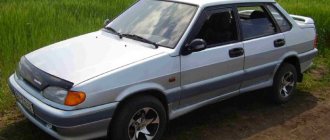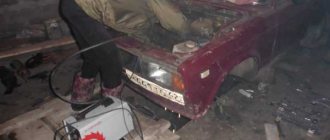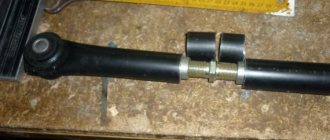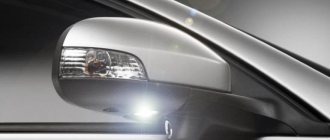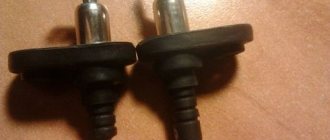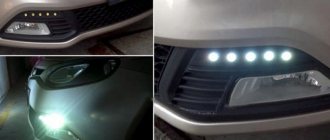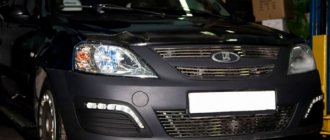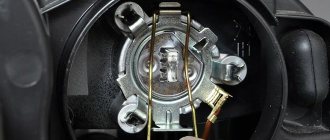Today we’ll talk about car parking lights. The difference between side lights and headlights is that they are used to improve visibility and indicate the dimensions of your car in the dark or when visibility is poor.
Many beginners forget about the side lights, which is a bad thing to do. If in old cars the side lights turned on together with the instrument lighting, and it was impossible to forget about it, in new cars everything is separated, and by turning on the instrument lights, you can forget about the dimensions - this cannot be done.
What are side lights?
Parking lights, also known as parking lights, are lights that are located on the sides, front, and rear of a vehicle.
The side lights must be turned on if you are driving in the dark, while braking and stopping, as well as while parking the car on the roadway or side of the road.
Front dimensions
The dimensions located on the front of the car are called sidelights and parking lamps. They are located on the same line along the edges on the front of the vehicle. Dimensions on trucks are located on the fenders. The front marker headlights must glow exclusively white.
According to the traffic rules of the Russian Federation, front lights are turned on at night in conditions of poor visibility together with other optical devices, such as fog lights, high beams and low beams.
Rear dimensions
Rear dimensions are installed in the corresponding part of the car on the sides along one line and are part of the headlights.
Rear lights should only be red and turn on at night when driving and stopping at the edge of the road. On trucks and buses, the dimensions are installed both in the upper and lower parts. Drivers often confuse headlights with low and high beam running lights and fog lights, which should not be allowed. All running lights have their own purpose.
What are they needed for?
Side lights are of particular importance when driving a vehicle. Purpose of side lights:
- designation of vehicle dimensions when visibility on the road is insufficient;
- as lighting when stopping;
- attracting the attention of other road users.
Traffic rules
The first to include the mandatory use of headlights in traffic regulations were the United States. The changes came into force in the 68th year of the last century. At the same time, such a resolution appeared in Canadian legislation. If the driver ignored these instructions, he was subject to a fine.
Moreover, these instructions applied to any type of mechanical device. Since the introduction of these changes, the number of accidents on the road has decreased by almost half.
If the car is stopped on the side of the road in the dark, be sure to leave the lights on. The rules do not prohibit the use of additional light, such as running lights. The main thing is that the car is clearly visible to other road users.
Side light color
As for the front dimensions, they should always be white. The rear ones are basically red. As for the side ones, the driver can use yellow, orange or blue light bulbs. Such strict restrictions are not the whim of law enforcement agencies. It’s just that the inconsistency in the car’s lighting confuses other road users. Especially if the driver “tunes” the front optics and installs red lights in them.
Fines
Although the details of the use of side lights are not strictly regulated in many rules (there is no separate fine for each violation), the driver may receive a warning or a receipt for payment for violating the rules in the following situations:
- The car is standing on the side of the road in the dark, there are passengers sitting in it, but the dimensions are not illuminated;
- The headlights are so dirty that their glow is hard to see;
- Driving in poor visibility only on clearance.
Some may regard strict rules in the use of car lighting as an infringement on self-expression. In fact, this is done solely for the sake of traffic safety.
Why use the function of automatically turning on the headlights and parking lights in your car?
The ANV high beam control system is becoming increasingly popular among car owners. Recently, it has become mandatory for installation for vehicles with a permissible maximum weight of up to 3.5 tons. Its main function is to switch headlights from high beam to low beam and back in automatic mode.
It was created primarily for safer driving at night. And, I must say, it copes with its task excellently. Visibility is significantly improved, and the light of your car does not blind oncoming people. In addition, the driver is freed from the need to be distracted from the road, constantly changing the operating modes of the headlights.
In addition, in accordance with Russian legislation, driving during daylight hours with low beam or fog lights on is mandatory. Violation may result in a fine, so you must constantly ensure that your headlights are on correctly.
At the same time, light assist is not free from shortcomings. And first of all, it does not work correctly in the off-season, in particular in the fall. And it has arrived not only on the calendar. Fog, frost, rain – road users constantly encounter these atmospheric conditions that are uncomfortable for driving.
And it is precisely in such weather that the ANV system does not function correctly, or rather, it is not activated and does not work. This is due to a fundamental flaw in its design. As already mentioned, it works without problems in low light, in the dark.
Here's how it's implemented, say, in Toyota cars: (video)
This happens because the car has a light sensor. It is also called a twilight or light sensor. It consists of a photocell, a control unit and a relay. When a car enters a low-light area, say a tunnel, the system automatically turns on the high beams without distracting the driver.
However, the aforementioned signs, which are so characteristic of the Russian off-season, such as fog, snow or rain, do not affect the level of illumination. But the automatic lighting system does not define them as a change between light and dark or day and night. And as a result, despite the dangerously poor visibility, we are still driving with daytime running lights.
This shortcoming of the high beam control system has been known for a long time. However, drivers have already become accustomed to its convenience and sometimes forget about possible tricks on its part in certain weather conditions.
But such forgetfulness can be costly. And not only for you. What does it mean - the road is poorly lit, visibility has deteriorated, the lights don’t light up? Answer: you are not just invisible on the road. You simply do not exist for other road users. And when your presence is finally discovered, the consequences of such a “find” can be unpredictable. It's good if it's just a fine. What if there is an accident?
Therefore, we strongly recommend that car owners whose cars are equipped with light assist do not rely on the tricks of technology, but use common sense: visibility has become worse, air transparency has decreased - turn on the low beam.
And we turn it on ourselves, by hand. And it’s a good idea to add fog lights to it.
When is it allowed to turn on
The traffic regulations stipulate when rear fog lights can be used.
In practice they are used:
- together with ordinary light;
- instead of low beams when road visibility is poor.
In any situations involving low lighting while driving, the use of additional lighting equipment is mandatory. However, you should not allow the fact of excessively bright light, as there is a risk of an emergency and blinding other drivers.
According to traffic regulations, if visibility deteriorates due to weather or additionally turned on headlights, the driver must reduce the speed of the car to an acceptable speed, trying to create maximum safety for road users.
If you are completely blinded by the headlights of oncoming vehicles, you should stop and turn on your hazard lights. Only after complete restoration of vision can the motorist continue driving. Compliance with this rule guarantees safety and minimal risk of accidents.
Features of using rear fog lights:
- During daylight hours with good visibility, fog lights can only be used separately from the low beam. But the use of ZPTF is strictly prohibited.
- At night, in the absence of bad weather conditions, the use of PTF is permissible only on unlit sections of the roadway and in conjunction with low-beam side lights. In this case, connecting rear fog lights is completely prohibited.
- The only condition when you can use the ZPTF is conditions of insufficient visibility during fog, rain, rain, snowfall, at dusk, etc. In this case, visibility should be less than 300 meters.
- In practice, the driver can independently determine the visibility distance and the need to use additional external lighting, as well as assess the risks of using certain light sources.
- Installation of PTF is considered mandatory. Otherwise, in the fog, the car may be recognized as a motorcycle or other small vehicle, which can provoke an accident.
- Ordinary flashlights cannot be used as fog lighting equipment.
- In fog or other bad weather conditions, the situation on the road cannot be assessed objectively. This means that slowing down and paying extra attention when using additional light is a must.
Compliance with such conditions regarding automotive lighting equipment reduces the risk of a possible accident in difficult circumstances and poor visibility.
Additional vehicle lighting symbols
Additional light markings for the body are required for trucks, since they are large, and in the dark it is necessary to accurately mark all the outer parts of the vehicle. By default, such vehicles must have the same lighting devices as passenger cars. Additionally, illumination of the side parts of the entire car is installed.
When installing such lighting, it is important that the bulbs do not differ in either brightness or color. The side lights of trucks must only be yellow or orange. Blue bulbs can be installed, but only as side markers.
An important condition when using additional illumination of dimensions is symmetrical installation. When using such lighting fixtures, you should purchase lamps made by the same manufacturer. Only if these two factors are observed can you be sure that large vehicles will be correctly marked at night. According to documents, some cars belong to the category of passenger transport; their dimensions are quite large. In such cases, owners of such vehicles install additional lights on the roof of the car. In addition to the fact that it looks beautiful, drivers of oncoming traffic can recognize the dimensions of the car. The main thing is that such lighting does not blind other road users.
Low beam, fog lights, DRLs and dimensions. Which of these should/can be turned on during the day?
DRLs are indeed called side lights, but they should not be confused with standard “dimensions”. If only because they (usually assembled in an LED strip as part of block headlights) shine many times brighter and are a means of ensuring safety for vehicles moving during the day.
The main function of DRLs is to indicate the position of a moving vehicle during the daytime. Their appearance in modern vehicles eliminates the need to turn on low beam headlights during the day. LEDs consume less energy than halogen lamps, and their light is clearly visible from several hundred meters away.
In Europe, the obligation for drivers to drive during the day with low beams on appeared long before the same rule was introduced in Russia. They say that the first people to turn on the lights during the day were in northern countries, where fogs are not uncommon. Later, automakers began to include DRLs for the reasons stated above. There was no longer any need to turn on the low beam specifically...
DRLs have been enshrined at the legislative level in Russia. So, according to clause 19.5. Traffic rules state that “during daylight hours, low beam headlights or daytime running lights must be turned on on all moving vehicles for the purpose of identifying them.”
As for the side lights, they must be turned on “when stopping and parking at night on unlit sections of roads, as well as in conditions of insufficient visibility” (clause 19.3. Traffic rules of the Russian Federation).
As you understand, side lights are not included in this list. If the driver ignores the requirement of the Rules, Article 12.20 of the Code of Administrative Offenses of the Russian Federation (“Use of external lighting devices and sound signals”) may be applied to him. It provides for punishment in the form of a fine of 500 rubles.
What do the Rules say about fog lights? The same section of the traffic rules - clause 19.4 - says that fog lights can be used in conditions of insufficient visibility with low or high beam headlights, at night on unlit sections of roads together with low or high beam headlights, and also instead of low beam headlights in in accordance with clause 19.5 of the Traffic Regulations.
During the day, your vehicle should have daytime running lights on while driving. If they are not there, low beam headlights or fog lights (without low beam or with it in conditions of poor visibility). Nothing complicated!
Driving during daylight hours
In good visibility
When driving during daylight hours, the vehicle must have one of the following lights on:
- low beam;
- Daytime Running Lights;
- fog lights;
If the car has all the listed devices, then it makes sense to use DRL. These lights are brighter and use less electricity.
When driving, the following can also be turned on:
- parking lights.
It is prohibited to use:
- fog lamp.
In case of insufficient visibility
One of the following lighting fixtures must be used:
- low beam headlights;
- high beam headlights.
In this case, the main beam cannot be used:
- in populated areas on illuminated roads;
- when oncoming vehicles pass;
- when blinding drivers of passing or oncoming cars.
Additionally, the car may include:
- fog lights;
- fog lamp;
- parking lights;
- Daytime Running Lights.
Note. The rear fog light is specifically designed for use in conditions of poor visibility, but in practice no more than 10 percent of drivers use it. The rest, apparently, do not know the relevant rules.
How to enable
When purchasing a new car, every motorist must not only check the technical condition of the vehicle, but also how all its options are turned on/off, including side lights. The reason is that in each car model, the switches are located in different parts of the control panel or on the steering column switches.
You should also figure out as soon as possible how different light bulbs are changed in order to understand whether it will be possible to carry out the replacement yourself in the event of a breakdown on the road. In some cars, the side light bulbs are located in a common headlight module, and replacing even the smallest bulb requires the services of service station specialists. In other machines this procedure is much simpler.
Types of devices and their design
Dimensions come in different types, as vehicles differ in size and design features. There are several groups, each with its own characteristics that you need to know:
- Standard front. They are also called parking lights or sidelights. Usually located in the low beam lamp, a low-power light bulb is used for this, which illuminates the element while parked. In some cars, the marker is placed separately or combined with the turn signal.
- Front LED. In many modern models, dimensions are achieved through LED elements, which can have different shapes and sizes. This part has become a recognizable design element that adds individuality. There are no special brightness requirements for the front elements, since even dim light is clearly visible in the dark.
- Rear. They can be either standard or LED, they work all the time when using low or high beam. There are no brightness requirements, but the light must be clearly visible at night and in poor visibility. In this case, the dimensions are part of the tail light and are most often located closer to the outside to better identify the car.
- Lateral. They can be located in the front or rear or along the entire side of the car, depending on the size of the vehicle. If the length is 6 meters or more, the minimum number of dimensions on the sides must be at least two. But usually more elements are used to better indicate transport.
- Upper. Also used on large cars and buses to indicate outlines in the dark and warn other drivers that large vehicles are moving in the same or oncoming direction.
- Side ones on the cab pillars. Used in older models of passenger cars. Nowadays they almost never meet.
As for the device, there are several features inherent to side lights:
- Typically the system consists of a reflector, diffuser and light bulb. Halogen or LED lamps are used as a light source; the second option is preferable, but is not suitable for all models. The design can be included in a headlight or lantern, or it can be separate, there are no strict restrictions.
- The front and rear dimensions are used in pairs. Therefore, you need to buy identical light bulbs so that they have the same luminous intensity and the angle of propagation of the luminous flux.
- When choosing bulbs for the rear, you need to remember that the side lights should not shine brighter than the brake light or direction indicators.
This option was used in some older models.
LEDs or halogens
Side marker lights Halogen bulbs are often used for side marker lights, but today manufacturers are increasingly using LED bulbs for car side marker lights. This choice is based on the functionality of the LEDs. LED side lights last much longer (up to 100,000 hours), the brightness of such bulbs is better, they consume less electricity, they are resistant to temperature fluctuations, vibration, and incorrect operation. Despite the increased cost of LEDs, their characteristics completely cover this disadvantage and quickly pay for themselves. The main thing, no matter what lights you choose for the parking lights, remember - they should not burn brighter than the brake lights.
What is the fine for high beam headlights in 2022?
So, we have considered the requirements of the Rules. The turn of responsibility for their violation has come. And there may be several penalties, depending on the specific violation.
General fine for traffic violations
In particular, this penalty will be imposed on the driver in the following cases:
- driving with high beams on a lit section of road in the city,
- blinding oncoming traffic,
- distant blinking as a warning about the traffic police crew
- and other violations of traffic regulations for the use of this light.
If it doesn't light up, when is it required?
Please note that the distant one does not need to be turned on at all in any case. Then the Rules give you the right to turn it on in all cases except those prohibited
But you have no obligation to use it under any road or weather conditions.
Therefore, in principle, there cannot be a fine for failure to use high beams. Another thing is that... read below.
If it doesn't work, is the lamp burnt out?
For example, you are driving with a distant driver, and your car is seen from afar by an inspector standing on the road. But one light bulb is not on, so, for example, the left headlight shines on high beams, and the right one shines on low beams.
Replacing side light bulbs in pre-restyling models
To do this, you must first prepare the car as indicated above (place it on a flat surface and turn off the engine), and then begin installation work:
- Open the hood and disconnect the negative cable from the battery (to avoid a short circuit).
- Remove the plugs that go to the lamps, and then remove the element into which the plug is installed.
- Turn the light bulb clockwise 45 - 60 degrees, then remove the spare part. To remove the lamp, gently pull it towards you. The socket itself first rotates along with the light source, then it is removed.
- Install a new light bulb and carry out the reverse dismantling.
This is interesting: The theory and operating principle of Ibadullaev’s engine: 3 new provisions in the theory of internal combustion engines
Penalty for having blue and green side lights on a car
Let us turn again to Article 12.5 of the Code of Administrative Offenses of the Russian Federation, from which it is clear that the punishment regarding the color of dimensions is quite severe. First of all, all “incorrect” devices will be removed and confiscated, and secondly, the driver will lose his right to drive a car for a fairly long period: from six months to one year. Isn't it harsh? And this, at first glance, is due to some devices and lights.
Code of Administrative Offenses of the Russian Federation Article 12.5. Driving a vehicle in the presence of malfunctions or conditions under which the operation of vehicles is prohibited, or a vehicle on which the identification sign “Disabled” is illegally installed. Driving a vehicle on the front part of which lights with red lights or red reflective devices are installed, as well as lighting devices, the color of the lights and the mode of operation of which do not comply with the requirements of the Basic Provisions for the admission of vehicles to operation and the duties of officials to ensure road safety - entails deprivation of the right to drive vehicles for a period of six months to one year with confiscation of the specified devices and accessories.
Of course, the decision on such a terrible punishment is made only by a judge and is carried out according to all the rules of the law, with the obligatory presence of a court order and act.
Confiscation of devices also happens for a reason, but always with two witnesses and a video recording of the procedure for removing the lighting devices. An act is drawn up and each action is recorded on the basis of Article 243 of the Civil Code of the Russian Federation. The driver has the right to challenge such actions in court. This is rarely crowned with success, because he himself is to blame.
Usually, upon arrest, the inspector charges the owner of the car, after which the above-mentioned actions take place.
According to statistics, cases with the installation of blue-green light bulbs on the dimensions are not so common, because even if they are sold in specialized stores, they are used primarily for illuminating the interior of a car or for illuminating the control panel, but not for external lighting . One can only be surprised at those craftsmen and extreme sports enthusiasts who risk their driving reputation and license for an incomprehensible “show off”.
So, let's summarize the main postulates that this article was devoted to. In paragraph 3.6, the list of various faults that prevent the car from moving anywhere clearly states the following:
- Only white, yellow or orange lights can be installed on the front of the car for lighting fixtures.
- Only red, yellow or orange lighting devices are allowed to be installed on the rear of the car.
- The number on the rear panel and the reverse lights are also only white.
Any other tint lamps are not allowed for use on mechanical vehicles, and if this simple rule is not followed, vehicle owners are severely punished.
Please note that there is no talk of blue, violet or green lights, and cannot be. So is it worth depriving yourself of the pleasure of driving your own car for the sake of its extraordinary appearance and “color show”, which confuses other road users and brings nothing but complications and troubles?
In general, the issue of road lighting for vehicles has several aspects, and drivers, especially of “cool cars,” often use halogen lamps; many cars have different ignition and connection methods. Each brand of car has its own characteristics, therefore, when replacing lighting devices, the driver should contact a specialist to install lighting devices that will not interfere with others on the road. Have a nice trip everyone!
Error codes on the Priora dashboard
When entering self-test mode, combinations of numbers and letters may appear on the display indicating the part of the circuit where a malfunction is detected.
Usually, after entering the service mode, one or more numbers appear on the device:
- 2 – a critical overvoltage was detected in the on-board network, caused by a short circuit or breakdown of the unit;
- 3 – an error has been detected in the fuel level sensor, a circuit break is possible;
- 4 – there is overheating of the cooling system, or the corresponding sensor is broken;
- 5 – the thermometer that determines the temperature outside is broken or there is an open circuit in versions before 2012, mounted optionally;
- 6 – the engine has boiled, you need to wait for cooling or check the serviceability of the sensors;
- 7 – the oil pressure in the crankcase of the power plant is too low, the sump may leak or the lubricant level has dropped significantly;
- 8 – breakdown of the brake line or units of the corresponding system;
- 9 – the battery is discharged or the element is faulty; it can also appear after the car has been idle for a long time in the cold;
- E – the firmware has failed or there is a critical error in the EEPROM data packet.
Fine for not turning on low beams
Good afternoon, dear reader.
This article will consider the fine for not turning on low beam headlights, as well as fines for other violations of the rules for using lighting devices.
Let me remind you that starting November 20, 2010, all moving vehicles must have either daytime running lights, low beam headlights, or fog lights on, regardless of the time of day and visibility conditions. Only here https://supdnya.ru/igrovye-avtomaty-vulkan-megadzhek/ there is a large selection of games.
However, quite often there are cars on the roads whose drivers forgot to turn on the low beams during the day. In addition, every day we come across moving cars in which one of the lighting devices (headlight or side light) does not light up.
This article will discuss fines for drivers of the vehicles listed above.
Fine for not turning on low beam headlights
To begin with, let me remind you that in order not to receive a fine for improper use of lighting devices, you just need to turn on the low beam headlights every time you get into the car. Current traffic regulations permit the use of low beams (together with side lights) day and night in all weather conditions.
In addition, low beam headlights are a sufficient condition for not receiving a fine for improper use of lighting devices. So, if your car has low beam headlights on and all the light bulbs in the headlights are working, then a traffic police fine related to lighting devices cannot be imposed.
If you violated the rules for using lighting devices, then the punishment will be a warning or a fine of 500 rubles (Article 12.20 of the Administrative Code).
However, let's look at situations in which a fine can still be imposed on the driver:
- When starting to drive, the driver forgot to turn on the low beam headlights. The situation is quite typical for daylight hours, because... Headlights that are not turned on during the day may not be immediately noticeable.
- In a car equipped with daytime running lights, the driver forgets to turn on the low beam when it gets dark.
- The driver forgets to switch the high beam headlights to low beam when entering an illuminated street in a populated area, or when approaching an oncoming vehicle.
- Use of the rear fog lamp in any conditions other than poor visibility.
Agree, the size of the punishment for the violation in question is not large. Nevertheless, I would like to remind you that when absolutely any traffic accident occurs, a driver who incorrectly uses lighting devices automatically becomes one of the culprits.
For example, in the event of a collision between cars, one of which is moving on the main road with the headlights turned off, and the other on a secondary road in compliance with traffic regulations, the drivers of both cars will most likely be found to be at fault for the accident. Those. each of them will be able to receive only half of the compensation from the insurance company.
At the same time, turning on the low beam or daytime running lights by the first driver will allow him to remain innocent and receive full compensation from the insurance company for car repairs.
